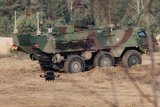Finland’s Dragon Shield achieves FOC
The Finnish Defence Forces’ Dragon Shield airborne surveillance system has achieved final operational capability (FOC) following the completion of flight testing, Lockheed Martin announced on 9 February.
The final flight test of the system evaluated the aircraft’s compliance to civilian and military airworthiness standards and verified system requirements.
Lockheed Martin modified a C295 cargo aircraft to accommodate a containerised surveillance system that rolls on and off the aircraft. The system features an open, modular architecture to enable the addition of future upgrades.
The company also provided the Finnish Defence Forces with ground stations and communications terminals to support the airborne system.
Rob Smith, vice president of C4ISTAR at Lockheed Martin, said: ‘Working in unison with our customer, we provided an innovative system that fulfils their dynamic requirements. We worked with Finnish industry to maximise industry participation to ensure that the system can be maintained in-country.’
Related Equipment in Defence Insight
More from Digital Battlespace
-
![Babcock nears first customer for Nomad AI translation tool]()
Babcock nears first customer for Nomad AI translation tool
Nomad can provide militaries with real-time intelligence, saving critical time on the battlefield.
-
![AUSA 2025: Israel’s Asio Technologies to supply hundreds of improved Taurus tactical systems]()
AUSA 2025: Israel’s Asio Technologies to supply hundreds of improved Taurus tactical systems
Taurus operates alongside the Israel Defense Forces’ Orion system which supports mission management across tens of thousands of manoeuvring forces, from squad leaders to battalion commanders.
-
![AUSA 2025: Kopin pushes micro-LED plans as China moves faster]()
AUSA 2025: Kopin pushes micro-LED plans as China moves faster
The plan for the new displays follows fresh investment in Kopin’s European facilities by Theon and an order for head-up displays in fielded aircraft, with funding from the US Department of Defense.
-
![AUSA 2025: Persistent Systems to complete its largest order by year’s end]()
AUSA 2025: Persistent Systems to complete its largest order by year’s end
Persistent Systems received its largest ever single order for its MPU5 devices and other systems earlier this month and has already delivered the 50 units to the US Army’s 4th Infantry Division.
-
![Aselsan brings in dozens of companies and systems under the Steel Dome umbrella]()
Aselsan brings in dozens of companies and systems under the Steel Dome umbrella
Turkey has joined the family of countries attempting to establish a multilayered air defence system with government approval in August 2024 for the effort landed by Aselsan. Dubbed Steel Dome, the programme joins Israel’s Iron Dome, the US Golden Dome, India’s Mission Sudarshan Chakra and South Korea’s low-altitude missile defence system.
-
![DSEI 2025: MARSS unveils new agnostic multidomain C4 system]()
DSEI 2025: MARSS unveils new agnostic multidomain C4 system
MARSS’ NiDAR system has been deployed using sensors from static platforms to provide detection and protection for static sights, such as critical infrastructure, ports and military bases.


























